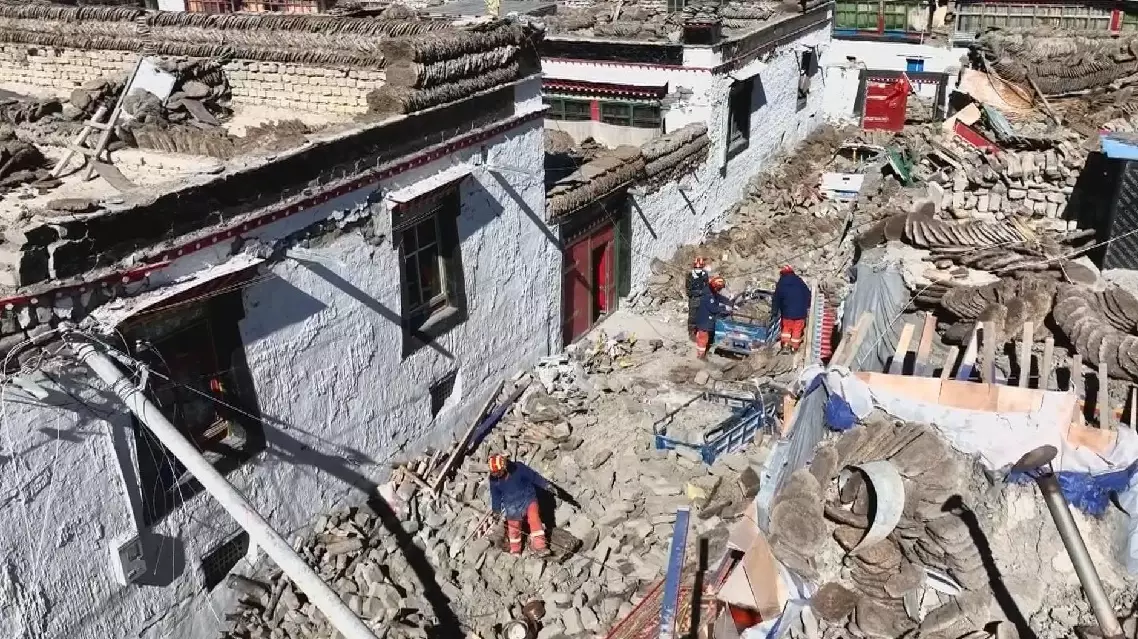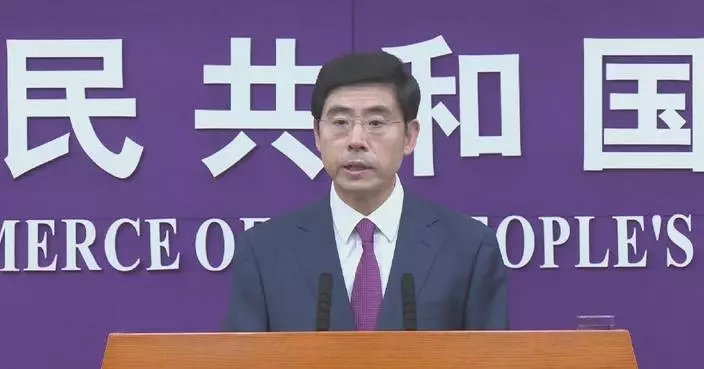Relief efforts are underway following Tuesday's deadly earthquake in southwest China's Xizang Autonomous Region, with a total of 407 people being rescued from debris and many prefabricated houses being set up at resettlement sites.
The powerful 6.8-magnitude quake struck Dingri County in Xigaze City on Tuesday morning, claiming at least 126 lives, injuring 188 others, and causing the collapse of more than 3,600 houses.
"We are doing our best to search for and rescue the injured, minimize casualties, and take good care of the affected people. We are making professional efforts to ensure effective emergency rescue, so that the affected people have enough food, clothing, and comfortable shelter," said He Wenlong, a member of the Chinese People's Armed Police (PAP) Force Xizang Contingent.
As of 06:00 Thursday, 61,500 people were affected by the earthquake. So far, a total of 224 resettlement sites have been set up for 47,500 relocated residents, with their basic living needs ensured.
As present temperatures can fall below minus 10 degrees Celsius, a key focus has been distributing winter relief items. Among them, a total of 12,730 tents have been set up, 1,572 stoves installed, 3,020 electric blankets and 104 trucks of fuel allocated to the disaster-afflicted area.
In the badly-hit Gurong Village and Cuo'ang Village of Dingri, prefabricated houses have been delivered to the resettlement sites, and rescuers are racing against time to erect temporary buildings for affected residents.
"The first batch of 400 prefabricated houses has been delivered. We plan to build 75 prefabricated houses in this village, and we are working to ensure that the power facilities for these houses are operational tonight, so that people could move in tomorrow. Our goal is to ensure that the affected residents are warm in winter," said Zang Hongxiao, construction manager of the resettlement site in Cuo'ang Village.
On Thursday, the Office of the National Disaster Prevention, Reduction and Relief Committee and the Ministry of Emergency Management coordinated with relevant departments to provide 10,000 tons of biomass fuel and 5,000 emergency lighting lamps. Up to now, the ministry has dispatched six teams, comprising 629 workers and 230 sets of equipment from a number of centrally-administered enterprises to conduct inspections of damaged houses, ensure electricity supply, and transport materials in the disaster-hit areas. The Ministry of Finance on Wednesday earmarked 80 million yuan (about 11 million U.S. dollars) in disaster relief funds to support agricultural production in the quake-hit area.
The ministry said in a statement on its website that the funding was earmarked in response to quake-caused damage to farming facilities, greenhouses and livestock sheds. It said the funding will support Xizang in disaster relief work related to agricultural production and the restoration of animal husbandry facilities damaged by the earthquake.
The funding will also provide subsidies for the purchase of equipment for pest and disease control, fuel, forage and other materials for post-disaster production, in an effort to restore agricultural production in the affected areas as soon as possible and minimize losses.
The Organization Department of the Communist Party of China (CPC) Central Committee has allocated 50 million yuan (about 6.82 million U.S. dollars) from Party membership fees for the rescue and disaster relief work in the quake-stricken areas.
After the earthquake occurred, the Ministry of Commerce immediately activated an emergency plan and coordinated with 627 key suppliers to strengthen the food supply. It allocated 743,000 tons of daily necessities, including grain, oil, meat and vegetables, and dispatched 2,000 tons of frozen pork, 1,600 tons of frozen beef and mutton, and 2,250 tons of tea from the central reserves.
Relevant local commercial authorities have dispatched 153,000 boxes of supplies, including instant noodles, bottled water, bread, rice cakes, and butter ghee, along with 73,000 items of daily essential materials such as electric blankets, heating stoves, quilts, cotton-padded clothes, and blankets to the quake-hit areas.

407 people rescued, temporary buildings set up in quake-hit Xizang
A youth-led and youth-oriented business model centered on consumption and innovation by and for young people has injected new vitality into the economic development of Shanghai.
In March, the Shanghai Municipal Committee of the Communist Youth League of China issued an implementation plan on promoting youth economy, proposing to provide the younger generation with more diverse and rich consumption options by creating youth-friendly blocks, building 24-hour service places, and incubating unique small stores, markets and stalls.
In recent years, Shanghai has seen a growing trend of young people flocking to night schools, as the stressed-out urban employees look for a place where they can acquire new skills, while rejuvenating themselves and expanding their social circles outside the workplace.
At Hong Shou Fang, an important commercial center renovated from old neighborhoods in Shanghai's Putuo District, the night school for young people have enriched the streets with a vibrant new addition.
Bakery owner Zhu Jiayin told China Central Television (CCTV) that the white-collar workers attending the evening classes have driven the orders of the shop to increase by 50 percent in the past few months.
"The revenue chart show that we used to have little business between 18:00 to 19:00 because it was dinner time and there were few people coming to the bakery. Now, the sales volume has increased significantly. The night school is quite helpful for us," he said.
The young businessman said he plans to adjust the variety of food, adding light dinners and set meals to meet the demands of the young consumers.
While boosting the nigh-time consumption in nearby restaurants, stores and entertainment place, the night schools in office buildings have also improved the utilization of commercial real estate in idle hours.
"The night schools have become a part of young people's consumption. It can not only help the youth refresh themselves, but also drive the development of night-time economy," said Wang Ying, head of the Hong Shou Fang project.
At present, the emerging business mode with night schools as the pivot has covered four commercial youth centers in Putuo District, and is expected to be promoted throughout the city. A "three-in-one" development pattern of "youth night school plus youth center plus youth consumption" is taking shape.
Shanghai has also been vigorously fostering consumption scenarios featuring innovative and distinctive stores to attract young people. Given that the start-ups generally face major problems such low brand recognition, difficulty in obtaining resources, and high innovation costs, the local government has stepped up its support for young entrepreneurs.
Changning District has the highest proportion of young people in the residential group in the city. It is committed to becoming an area of hope for the young generation with a vibrant new consumption landscape.
At Yuyuan Road, a representative historical and cultural block, photography workshop runner Dong Jiahong has embraced a new lease of life for his business.
Dong's store has creatively launched pupil photography, capturing the unique color and texture in the iris with a macro lens. However, due to the relatively niche consumer base, the returns were not satisfactory.
The turning point emerged in March, when the store was selected to be presented at Changning's first youth economy market. Local authorities specially arranged mentors to provide guidance from store design to marketing promotion, and gave the store more exposure.
"The market didn't charge booth fees. The official WeChat account of the government helped further promote us online, giving publicity to such things as the features and locations of our store. I think this is very good," Dong said.
The government of Changning District has set up a special service group for the youth economy practitioners, tailoring online and offline display platforms for over 70 small stores to help young entrepreneurs attract customers and expand market channels.
In March, the district announced a targeted policy of providing full-cycle support for young entrepreneurs in terms of financial assistance, space matchmaking, and traffic promotion.
"With the resources of our platform, we integrate all the youth economy owners to promote the conversion of customer traffic into sales, and facilitate more cooperation in business operations," said Li Lei, chairman of the Youth Innovative Talent Development Center of Changning.

Youth-oriented business model invigorates Shanghai's economy























































